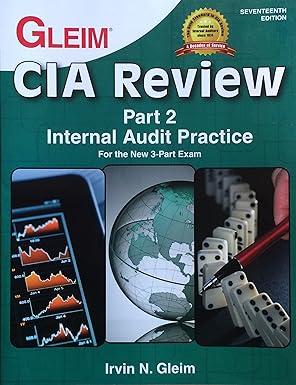Question
Ex. 15-2 Select the best answer. A key determinant as to whether, under Circular A133, a program is considered major or nonmajor is The overall
Ex. 15-2
Select the best answer.
- A key determinant as to whether, under Circular A133, a program is considered major or nonmajor is
- The overall size of the program as measured by total revenues, regardless of source
- The overall size of the program as measured by total assets
- The amount of federal aid received
- Its score on the OMB risk assessment scale
- General compliance requirements are set forth in
- The Yellow Book
- The Single Audit Act
- The compliance supplement to Circular A133
- The AICPA's generally accepted auditing standards
- Which of the following is not particularly indicative of a programs exposure to risk:
- Engagement of new independent auditors
- Recently installed and untested computer systems
- Past inefficiencies as revealed in previous audits
- Ineffective administration
- Per OMB Circular A133, the Schedule of Expenditures of Federal Awards
- Must be explicitly tested and reported on by the auditors
- Should serve to help auditors to determine the scope of their audit work but need not be explicitly tested
- Must be tested but need be reported on by the auditors only if the tests reveal material errors
- Must be explicitly tested and reported on by the auditors only if the total of federal awards is material relative to total expenditures
- Which of the following would not be reported on in the Schedule of Findings and Questioned Costs?
- Significant deficiencies in internal control
- Material noncompliance with provisions of laws, regulations, contracts, or grant agreements
- Material examples of inefficiency and ineffectiveness in carrying out federally funded programs
- Federally reimbursed expenditures that are not adequately documented
- The requirement for a report on the schedule of findings and questioned costs is set forth in the
- AICPA's Professional Standards
- GAO's Government Auditing Standards
- Single Audit Act
- OMB Circular A133
- The GAO standards pertaining to performance audits
- Mandate that programs be audited annually
- Mandate that programs be audited whenever information comes to the attention of the auditor indicating a need for a performance audit
- Mandate that a complete audit include both a financial audit and a performance audit
- Do not specify when and how often a program must be audited
- Performance audits differ from financial audits in that
- The GAO's general standards do not apply to performance audits
- In conducting performance audits, the auditors do not necessarily attest to assertions of management
- The auditors need not issue a formal report setting forth their findings
- The main focus should be on activities that satisfy the criteria of Circular A133 as major programs
- In discerning the objectives of a program to be audited, the auditors should give the greatest credibility to
- The legislation creating the program
- The organization's program budget
- The organization's mission statement and strategic plan
- Comments by the midlevel employees who actually implement the program
- In reporting the results of a performance audit, it would be inappropriate for the auditors to
- Conjecture as to the reasons for the program's failure to achieve desired results
- Include the auditors' response to management's objections to the auditors' findings
- Provide recommendations as to how the program can be improved
- Criticize management for failing to establish appropriate goals and objectives
P. 15-2
Even programs involving relatively subjective judgments can readily be audited.
A Department of Housing and Urban Development (HUD) program is aimed at conserving and rehabilitating blighted but salvageable urban areas. One element of the program provides that HUD will make rehabilitation grants and lowinterest loans to property owners to help them finance the repairs needed to bring their properties into compliance with housing codes.
When Congress authorized the program, it did not establish specific criteria as to what constitutes a blighted but salvageable area; it left that up to HUD.
A preliminary survey by the GAO has indicated that HUD is directing funds to areas that were far too deteriorated for conservation and rehabilitation to work.
Suppose that you are assigned to the engagement. Outline an approach that you would take to support (or reject) the findings of the preliminary survey.
Step by Step Solution
There are 3 Steps involved in it
Step: 1

Get Instant Access to Expert-Tailored Solutions
See step-by-step solutions with expert insights and AI powered tools for academic success
Step: 2

Step: 3

Ace Your Homework with AI
Get the answers you need in no time with our AI-driven, step-by-step assistance
Get Started


